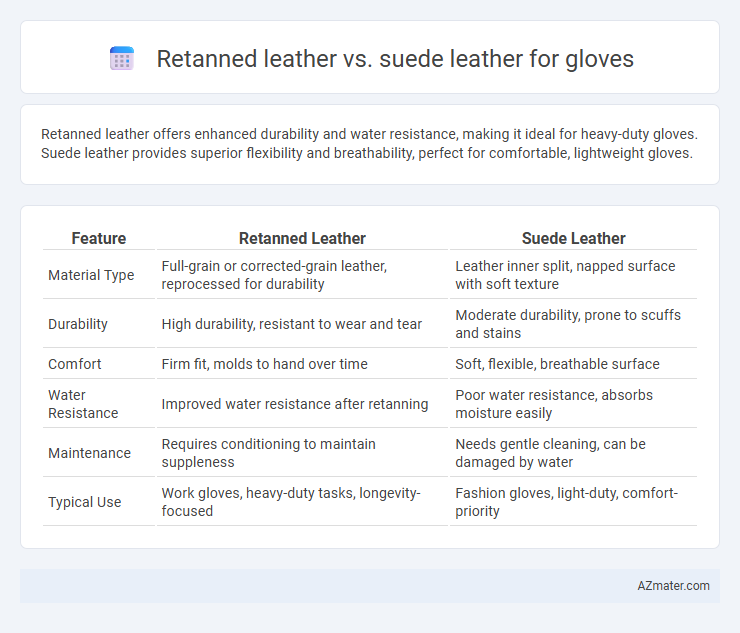Retanned leather offers enhanced durability and water resistance, making it ideal for heavy-duty gloves. Suede leather provides superior flexibility and breathability, perfect for comfortable, lightweight gloves.
Table of Comparison
| Feature | Retanned Leather | Suede Leather |
|---|---|---|
| Material Type | Full-grain or corrected-grain leather, reprocessed for durability | Leather inner split, napped surface with soft texture |
| Durability | High durability, resistant to wear and tear | Moderate durability, prone to scuffs and stains |
| Comfort | Firm fit, molds to hand over time | Soft, flexible, breathable surface |
| Water Resistance | Improved water resistance after retanning | Poor water resistance, absorbs moisture easily |
| Maintenance | Requires conditioning to maintain suppleness | Needs gentle cleaning, can be damaged by water |
| Typical Use | Work gloves, heavy-duty tasks, longevity-focused | Fashion gloves, light-duty, comfort-priority |
Overview: Retanned Leather vs Suede Leather
Retanned leather offers enhanced durability and water resistance due to its additional tanning process, making it ideal for heavy-duty gloves that require strong protection and longevity. Suede leather, characterized by its soft and fuzzy texture from the underside of the hide, provides flexibility and breathability, suitable for gloves needing comfort and a lightweight feel. The choice between retanned leather and suede leather gloves depends on performance requirements such as abrasion resistance versus tactile sensitivity and style preferences.
Understanding Retanned Leather: Key Features
Retanned leather, known for its enhanced durability and improved water resistance, undergoes a secondary tanning process that strengthens fibers, making it ideal for gloves requiring robust protection and longevity. Unlike suede leather, which is soft and has a napped finish created from the inner split of the hide, retanned leather offers a smoother surface with increased thickness and resilience against wear and tear. Its key features include superior abrasion resistance, better shape retention, and a denser texture, ensuring gloves crafted from retanned leather provide both comfort and extended usability.
Suede Leather Explained: Texture and Qualities
Suede leather, characterized by its soft, napped texture, is created from the underside of animal hides, offering a supple and flexible feel ideal for gloves requiring dexterity and comfort. Its porous surface enhances breathability but demands careful maintenance to prevent stains and water damage compared to retanned leather, which is thicker, more durable, and resistant to wear. Suede gloves are favored for their lightweight warmth and stylish matte finish, making them popular in fashion and light-duty work applications.
Comparing Softness and Comfort Levels
Retanned leather typically offers a firmer texture with enhanced durability, making it less soft but more supportive for gloves, while suede leather provides a velvety, plush surface that increases softness and comfort but may sacrifice some longevity. Suede's raised fibers contribute to superior breathability and flexibility, ideal for applications demanding comfort and tactile sensitivity. Retanned leather gloves excel in structural integrity and resistance to wear, whereas suede prioritizes a cushioned feel and adaptability to hand movement.
Durability and Lifespan: Which Lasts Longer?
Retanned leather typically offers superior durability and extends the lifespan of gloves compared to suede leather due to its dense fiber structure and enhanced tanning process that increases resistance to wear and moisture. Suede leather, while softer and more flexible, tends to absorb dirt and moisture more easily, leading to quicker degradation and reduced overall longevity. For heavy-duty use or environments requiring long-lasting protection, retanned leather gloves are generally the better choice due to their hardened surface and improved strength.
Grip and Flexibility: Performance in Gloves
Retanned leather offers enhanced grip and durability due to its denser fiber structure, making it ideal for heavy-duty gloves requiring strong grip and abrasion resistance. Suede leather provides superior flexibility and softness, allowing for greater dexterity and comfort in gloves used for precision tasks. The choice between retanned and suede leather impacts overall glove performance, with retanned leather excelling in grip strength and suede optimizing finger movement and tactile sensitivity.
Water Resistance and Moisture Management
Retanned leather offers superior water resistance compared to suede leather, making it ideal for gloves exposed to wet conditions. Suede leather, with its open, porous surface, excels in moisture management by allowing better breathability and faster drying, though it absorbs water more readily. Choosing retanned leather enhances durability and protection against moisture, while suede provides comfort and ventilation in dry environments.
Maintenance and Cleaning Requirements
Retanned leather gloves require minimal maintenance, often needing only occasional wiping with a damp cloth and conditioning to maintain flexibility and prevent cracking. Suede leather gloves demand more careful cleaning, as their napped surface can trap dirt and stains easily, requiring specialized suede brushes and cleaning agents to preserve texture and appearance. Both types benefit from avoiding excessive moisture, but suede gloves are inherently more sensitive to water and staining compared to the durable, sealed surface of retanned leather.
Cost Considerations for Glove Manufacturers
Retanned leather typically incurs higher costs for glove manufacturers due to its extended processing time and additional chemical treatments, resulting in enhanced durability and water resistance. Suede leather offers a more affordable option by utilizing the underside of the hide, but it tends to be less resilient and requires more frequent replacement in heavy-use gloves. Manufacturers must balance these cost considerations against performance requirements and target market preferences when selecting between retanned and suede leather for glove production.
Best Use Cases: Choosing the Ideal Leather for Gloves
Retanned leather offers enhanced durability and water resistance, making it ideal for heavy-duty gloves used in construction, gardening, and industrial work. Suede leather provides superior breathability and flexibility, perfect for lightweight gloves designed for casual wear, driving, or tasks requiring dexterity. Choosing between retanned and suede leather depends on the balance between protection and comfort needed for specific glove applications.

Infographic: Retanned leather vs Suede leather for Glove
 azmater.com
azmater.com